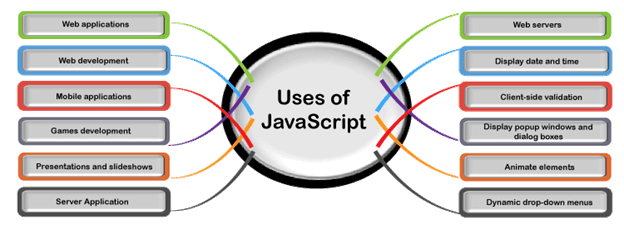-
JavaScript Tutorial
JavaScript Basics
- js-comment
- js-variable
- js-global-variable
- js-data-types
- js-operators
- js-if-statement
- js-switch
- js-loop
- js-function
JavaScript Objects
JavaScript BOM
JavaScript DOM
- 5)-document-object
- getelementbyid
- getelementsbyclassname()
- getelementsbyname
- getelementsbytagname
- js-innerhtml-property
- js-innertext-property
JavaScript Validation
JavaScript OOPs
- js-class
- js-object
- js-prototype
- js-constructor-method
- js-static-method
- js-encapsulation
- js-inheritance
- js-polymorphism
- js-abstraction
JavaScript Cookies
JavaScript Events
- javascript-events
- javascript-addeventlistener()
- js-onclick-event
- js-dblclick-event
- js-onload-event
- js-onresize-event
Exception Handling
JavaScript Misc
- js-this-keyword
- js-debugging
- js-hoisting
- js-strict-mode
- javascript-promise
- js-compare-dates
- javascript-array.length
- javascript-alert()
- javascript-eval()-function
- javascript-closest()
- javascript-continue-statement
- js-getattribute()-method
- js-hide-elements
- javascript-prompt()
- removeattribute()-method
- javascript-reset
- javascript-return
- js-string-split()
- js-typeof-operator
- js-ternary-operator
- js-reload()-method
- js-setattribute()-method
- js-setinterval()-method
- js-settimeout()-method
- js-string-includes()-method
- calculate-current-week-number-in-javascript
- calculate-days-between-two-dates-in-javascript
- javascript-string-trim()
- javascript-timer
- remove-elements-from-array
- javascript-localstorage
- javascript-offsetheight
- confirm-password-validation
- static-vs-const
- how-to-convert-comma-separated-string-into-an-array-in-javascript
- calculate-age-using-javascript
- javascript-label-statement
- javascript-string-with-quotes
- how-to-create-dropdown-list-using-javascript
- how-to-disable-radio-button-using-javascript
JavaScript Advance
- js-typedarray
- js-set
- js-map
- js-weakset
- js-weakmap
- javascript-callback
- javascript-closures
- javascript-date-difference
- javascript-date-format
- js-date-parse()-method
- javascript-defer
- javascript-redirect
- javascript-scope
- javascript-scroll
- javascript-sleep
- javascript-void
- javascript-form
Differences
Questions
- how-to-add-javascript-to-html
- how-to-enable-javascript-in-my-browser
- difference-between-java-and-javascript
- how-to-call-javascript-function-in-html
- how-to-write-a-function-in-javascript
- is-javascript-case-sensitive
- how-does-javascript-work
- how-to-debug-javascript
- how-to-enable-javascript-on-android
- what-is-a-promise-in-javascript
- what-is-hoisting-in-javascript
- what-is-vanilla-javascript
- how-to-add-a-class-to-an-element-using-javascript
- how-to-calculate-the-perimeter-and-area-of-a-circle-using-javascript
- how-to-create-an-image-map-in-javascript
- how-to-find-factorial-of-a-number-in-javascript
- how-to-get-the-value-of-pi-using-javascript
- how-to-make-a-text-italic-using-javascript
- what-are-the-uses-of-javascript
- how-to-get-all-checked-checkbox-value-in-javascript
- how-to-open-json-file
- random-image-generator-in-javascript
- how-to-add-object-in-array-using-javascript
- javascript-window-open-method
- javascript-window-close-method
- how-to-check-a-radio-button-using-javascript
- javascript-const
- javascript-function-to-check-array-is-empty-or-not
- javascript-multi-line-string
- javascript-anonymous-functions
- implementing-javascript-stack-using-array
- javascript-classlist
- javascript-code-editors
- javascript-let-keyword
- random-string-generator-using-javascript
- javascript-queue
- event-bubbling-and-capturing-in-javascript
- how-to-select-all-checkboxes-using-javascript
- javascript-change-event
- javascript-focusout-event
- traverse-array-object-using-javascript
- javascript-create-and-download-csv-file
- how-to-make-beep-sound-in-javascript
- how-to-add-a-whatsapp-share-button-in-a-website-using-javascript
- javascript-execution-context
- javascript-queryselector
- shallow-copy-in-javascript
- how-to-toggle-password-visibility-in-javascript
- removing-duplicate-from-arrays
- javascript-insertbefore
- javascript-select-option
Interview Questions
What are the uses of JavaScript?JavaScript is a light-weight object-oriented programming language that is used by several websites for scripting the webpages. It is an interpreted, full-fledged programming language. JavaScript enables dynamic interactivity on websites when it is applied to an HTML document. JavaScript helps the users to build modern web applications to interact directly without reloading the page every time. JavaScript is commonly used to dynamically modify HTML and CSS to update a user interface by the DOM API. It is mainly used in web applications. Let's discuss the uses of JavaScript. Some of the uses of JavaScript are representing in the following image.  1. Web ApplicationsAs day-by-day there is a continuous improvement in the browsers, so JavaScript gained popularity for making robust web applications. We can understand it by taking the example of Google Maps. In Maps user just requires to click and drag the mouse; the details are visible just by a click. There is a use of JavaScript behind these concepts. 2. Web DevelopmentJavaScript is commonly used for creating web pages. It allows us to add dynamic behavior to the webpage and add special effects to the webpage. On websites, it is mainly used for validation purposes. JavaScript helps us to execute complex actions and also enables the interaction of websites with visitors. Using JavaScript, it is also possible to load the content in a document without reloading the webpage. 3. Mobile ApplicationsNow a day's mobile devices are broadly used for accessing the internet. Using JavaScript, we can also build an application for non-web contexts. The features and uses of JavaScript make it a powerful tool for creating mobile applications. The React Native is the widely used JavaScript framework for creating mobile applications. Using React Native, we can build mobile applications for different operating systems. We do not require writing different codes for the iOS and Android operating systems. We only need to write it once and run it on different platforms. 4. GameJavaScript is also used for creating games. It has various libraries and frameworks for creating a game. The game can either be a 2D or 3D. Some JavaScript game engines such as PhysicsJS, Pixi.js help us to create a web game. We can also use the WebGL (web graphics library), which is the JavaScript API to render 2D and 3D images on browsers. 5. PresentationsJavaScript also helps us to create presentations as a website. The libraries, such as RevealJs, and BespokeJs, can be used to create a web-based slide deck. They are easier to use, so we can easily make something amazing in a short time. The Reveal.js is used to create interactive and beautiful slide decks with the help of HTML. These presentations work great with mobile devices and tablets. It also supports all of the CSS color formats. The BespokeJS includes animated bullet lists, responsive scaling, and a wide variety of features. 6. Server ApplicationsA large number of web applications have a server-side to them. JavaScript is used to generate content and handle HTTP requests. JavaScript can also run on servers through Node.js. The Node.js provides an environment containing the necessary tools required for JavaScript to run on servers. 7. Web ServersA web server can be created by using Node.js. Node.js is event-driven and not waits for the response of the previous call. The servers created using Node.js are fast and don't use buffering and transfer chunks of data. The HTTP module can be used to create the server by using the createServer() method. This method executes when someone tries to access the port 8080. As a response, the HTTP server should display HTML and should be included in the HTTP header. In this article, we discussed various JavaScript applications. JavaScript has various other uses that help us to improve the performance of webpages. The other uses of JavaScript are listed as follows:
|